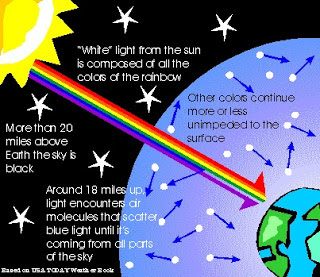Light from the sun is yellowish-white, so why does the atmosphere, which receives the light, appear blue?
Sunlight, before being bounced by the atmosphere, is actually made up of the light of all different colours. Each colour results fro...
http://getallsolved.blogspot.com/2013/08/light-from-sun-is-yellowish-white-so.html
Sunlight, before being bounced by the atmosphere, is actually made up of the light of all different colours. Each colour results from a certain wavelength of electromagnetic radiation: Blue from shorter wavelength, red from longer ones, and the rest of the rainbow from wavelengths in between. White corresponds to no specific wavelength. Instead, it is the colour our eyes register when we see all colours at once, as when we look at the sun. But when we look at the atmosphere, we see light that has been scattered by tiny atoms of oxygen and nitrogen--small even compared with the minuscule wavelengths of light. Such tiny particles tend to scatter short-wavelength light more strongly than long-wavelength light. Blue light, with a wavelength 30 percent shorter than red’s, is scattered five times more strongly. Hence, the sky appears blue. But at sunset, when sunlight passes through air closer to the ground, it is more likely to encounter larger particles, such as dust. These particles scatter more light of longer wavelengths, so the evening sky often appears reddish. Water droplets, larger still than dust particles, scatter all wavelengths of the light fairly equally--thus clouds appear white.












.jpg)
